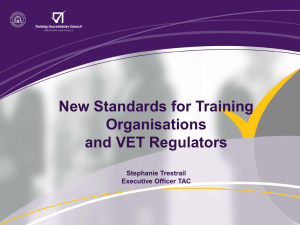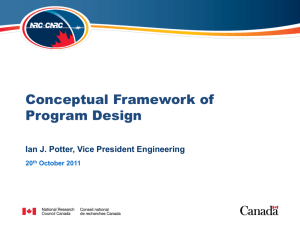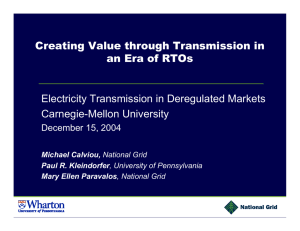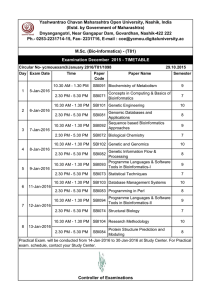Explanatory Statement Standards for Registered Training
advertisement
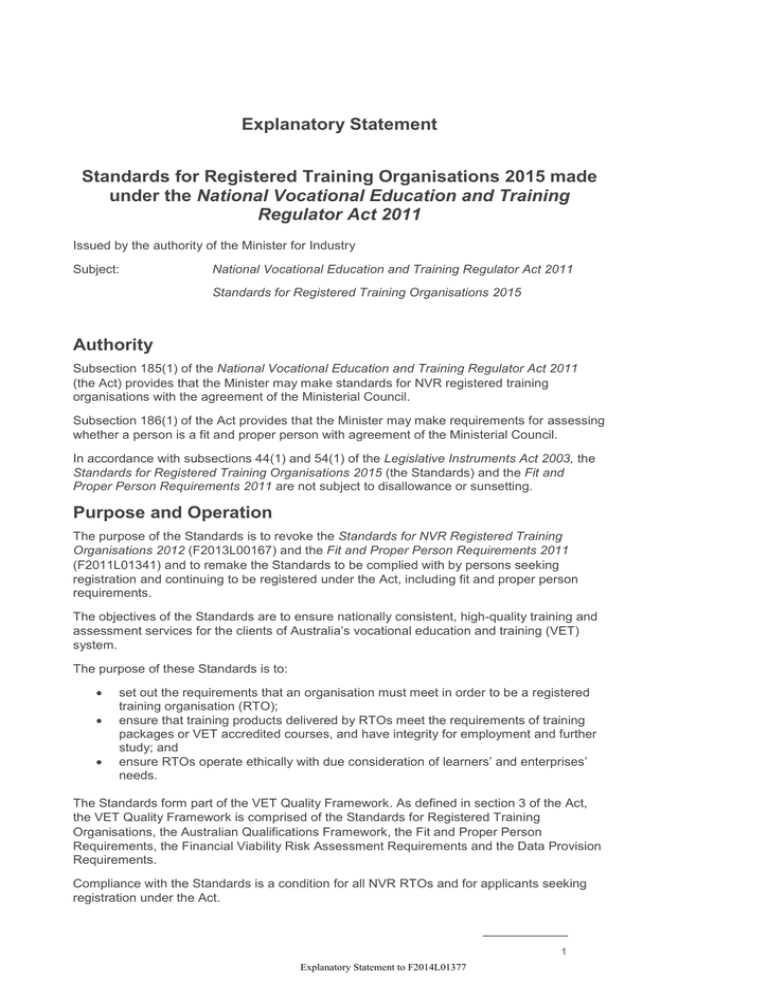
Explanatory Statement Standards for Registered Training Organisations 2015 made under the National Vocational Education and Training Regulator Act 2011 Issued by the authority of the Minister for Industry Subject: National Vocational Education and Training Regulator Act 2011 Standards for Registered Training Organisations 2015 Authority Subsection 185(1) of the National Vocational Education and Training Regulator Act 2011 (the Act) provides that the Minister may make standards for NVR registered training organisations with the agreement of the Ministerial Council. Subsection 186(1) of the Act provides that the Minister may make requirements for assessing whether a person is a fit and proper person with agreement of the Ministerial Council. In accordance with subsections 44(1) and 54(1) of the Legislative Instruments Act 2003, the Standards for Registered Training Organisations 2015 (the Standards) and the Fit and Proper Person Requirements 2011 are not subject to disallowance or sunsetting. Purpose and Operation The purpose of the Standards is to revoke the Standards for NVR Registered Training Organisations 2012 (F2013L00167) and the Fit and Proper Person Requirements 2011 (F2011L01341) and to remake the Standards to be complied with by persons seeking registration and continuing to be registered under the Act, including fit and proper person requirements. The objectives of the Standards are to ensure nationally consistent, high-quality training and assessment services for the clients of Australia’s vocational education and training (VET) system. The purpose of these Standards is to: set out the requirements that an organisation must meet in order to be a registered training organisation (RTO); ensure that training products delivered by RTOs meet the requirements of training packages or VET accredited courses, and have integrity for employment and further study; and ensure RTOs operate ethically with due consideration of learners’ and enterprises’ needs. The Standards form part of the VET Quality Framework. As defined in section 3 of the Act, the VET Quality Framework is comprised of the Standards for Registered Training Organisations, the Australian Qualifications Framework, the Fit and Proper Person Requirements, the Financial Viability Risk Assessment Requirements and the Data Provision Requirements. Compliance with the Standards is a condition for all NVR RTOs and for applicants seeking registration under the Act. 1 Explanatory Statement to F2014L01377 Consultation In April 2014, the Australian Government commenced a review of the standards for RTOs and VET Regulators as part of its broader VET reform agenda, with a view to ensuring that the standards are consistent with the Australian Government’s current VET reform priorities including industry responsiveness, improving quality and reducing the complexity of the regulatory framework. The Minister released the new draft standards for public consultation in June 2014. In total 128 submissions were received from RTOs, employers, training provider peak bodies, industry associations, Industry Skills Councils, and interested individuals as part of this process. Before the Minister made the Standards, they were endorsed by Ministers at the Council of Australian Governments (COAG) Industry and Skills Council meeting on 26 September 2014. Description of the provisions of the Standards Part 1 – Preliminary Names the Standards for Registered Training Organisations 2015, provides the purpose of the Standards, describes the structure of the Standards and provides a glossary of defined terms used throughout the Standards. Part 2 – Training and assessment Standard 1: The RTO’s training and assessment strategies and practices are responsive to industry and learner needs and meet the requirements of training packages and VET accredited courses. Sets out the requirements for an RTO’s training and assessment strategies and practices to ensure the provision of high quality training and assessment. The RTO’s training and assessment strategies and practices must have regard to the amount of training required for the learner to gain the competencies as specified in the relevant training package or VET accredited course. Requires the RTO to implement a comprehensive plan of systematic validation of its assessment practices and results, based on risk. Sets the minimum qualification requirements for all trainers and assessors including those working under supervision. Identifies the requirements for an RTO delivering any qualification or skill set from the Training and Education Training Package including qualification requirements, supervision and independent validation. Standard 2: The operations of the RTO are quality assured. Identifies that the RTO is ultimately responsible for ensuring quality training and assessment within their organisation and scope of registration, regardless of any third party arrangements. Sets out the requirements for an RTO to systematically monitor and evaluate its training and assessment strategies and practices to ensure ongoing compliance with the Standards. Requires the RTO to have a written agreement with any third party delivering services on its behalf and to ensure that it has sufficient strategies and resources to systematically monitor any services delivered this way. 2 Explanatory Statement to F2014L01377 Standard 3: The RTO issues, maintains and accepts AQF certification documentation in accordance with the Standards and provides access to learner records. Sets the requirements for an RTO in issuing, maintaining and accepting Australian Qualifications Framework (AQF) certification documentation, to ensure qualifications, statements of attainment and records of results are not issued unless the learner has completed all requirements. Requires the RTO to issue certification documentation to learners within 30 days of the learner completing or exiting their course. Sets out the requirements of the RTO in relation to the Student Identifier Scheme. Part 3 – Obligations to learners and clients Standard 4: Accurate and accessible information about an RTO, its services and performance is available to inform prospective and current learners and clients. Identifies the requirements on an RTO to ensure that transparent and accurate information about its services and performance is accessible to prospective and current learners and clients. Standard 5: Each learner is properly informed and protected. Requires the RTO to provide learners with information prior to commencement of services including any third party arrangements affecting the delivery of training and/or assessment, outlining the services to be provided to the learner, the rights and obligations of the learner and RTO, and to make information available about fees and rights to obtain a refund for services not provided. Standard 6: Complaints and appeals are recorded, acknowledged and dealt with fairly, efficiently and effectively. Requires the RTO to have a transparent complaints and appeals policy that enables learners and clients to be informed of and understand their rights and the RTO’s responsibilities under the Standards. Part 4 – RTO governance and administration Standard 7: The RTO has effective governance and administration arrangements in place. Identifies the requirements of the RTOs governance arrangements, including ensuring authorised executive officers are in place and satisfying the Financial Viability Risk Assessment Requirements and Data Provision Requirements. Requires the RTO to have suitable arrangements in place when collecting fees in excess of $1500 in advance by meeting the Requirements for Fee Protection. Makes holding public liability insurance a requirement of registration. Standard 8: The RTO cooperates with the VET Regulator and is legally compliant at all times. Sets out the requirements for RTOs, and any third party delivering services on its behalf, to comply with the Standards, the VET Regulator and any other relevant Commonwealth, State and Territory legislation. Includes the requirement for RTOs to document any third party arrangements and to notify the VET Regulator of these arrangements and for the RTO to provide an annual declaration on compliance with the Standards to the VET Regulator. Schedule 1 Sets out the training and assessment AQF qualification or skill set requirements for trainers and assessors. 3 Explanatory Statement to F2014L01377 Schedule 2 Sets out the independent validation requirement for RTOs delivering training and assessment qualifications or assessor skill sets from the Training and Education Training Package. Schedule 3 Sets out the fit and proper person requirements, made under subsection 186 (1) of the National Vocational Education and Training Regulator Act 2011. Schedule 4 Sets out the conditions of use of the Nationally Recognised Training (NRT) Logo. Schedule 5 Sets out the requirements for issuing AQF qualifications and statements of attainment. Schedule 6 Sets out the requirements for protecting fees prepaid by individual learners, or prospective learners, for services. 4 Explanatory Statement to F2014L01377
